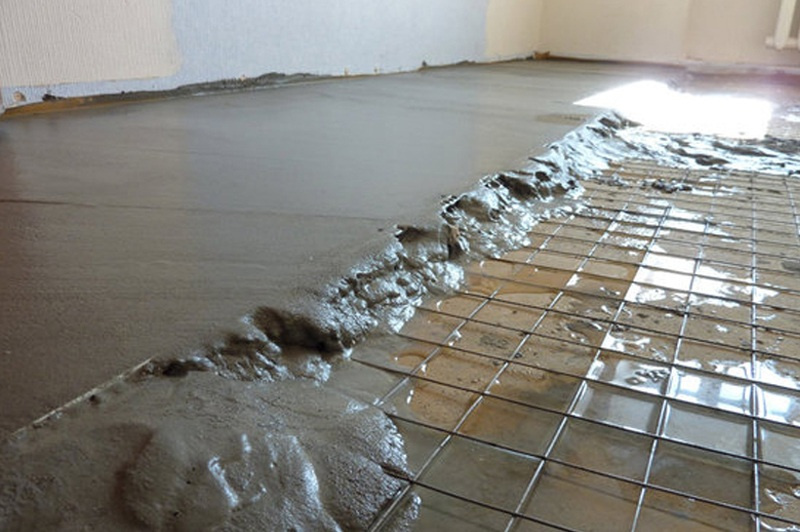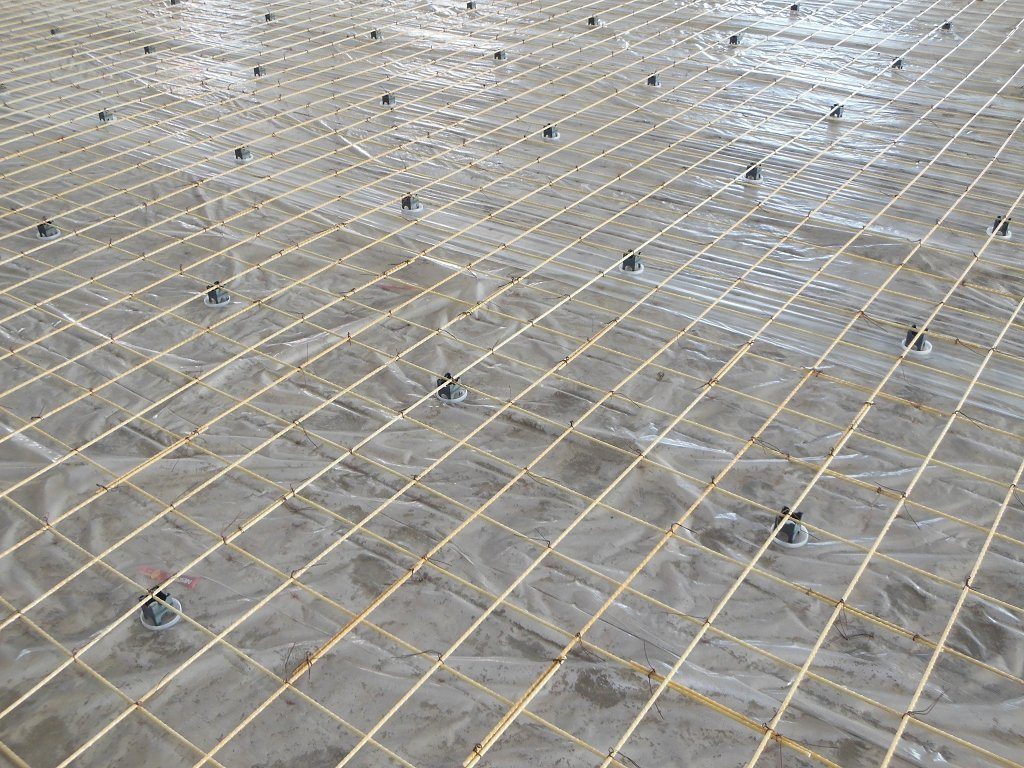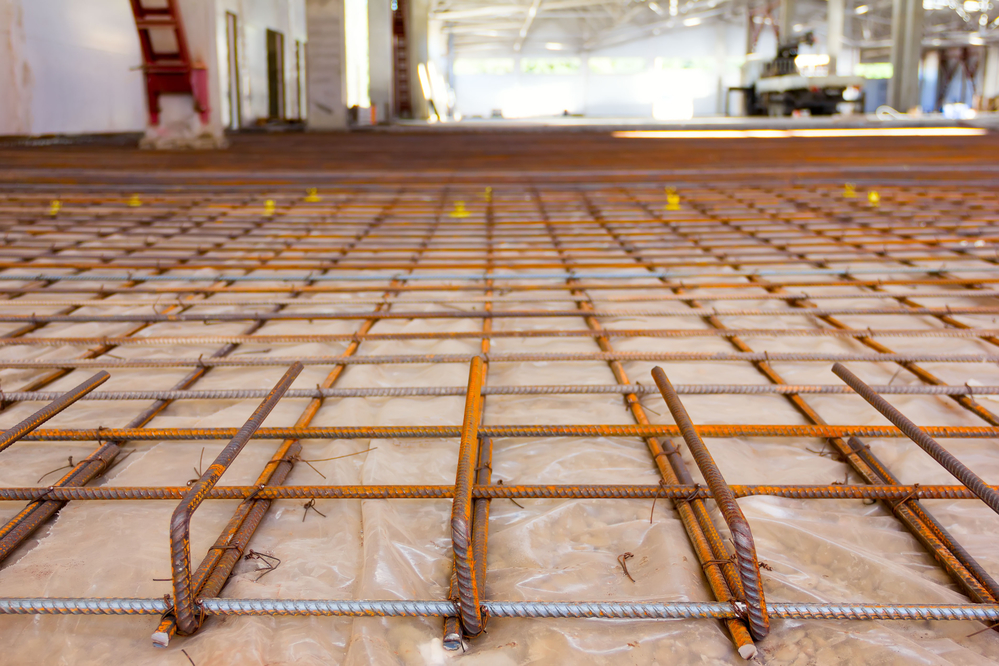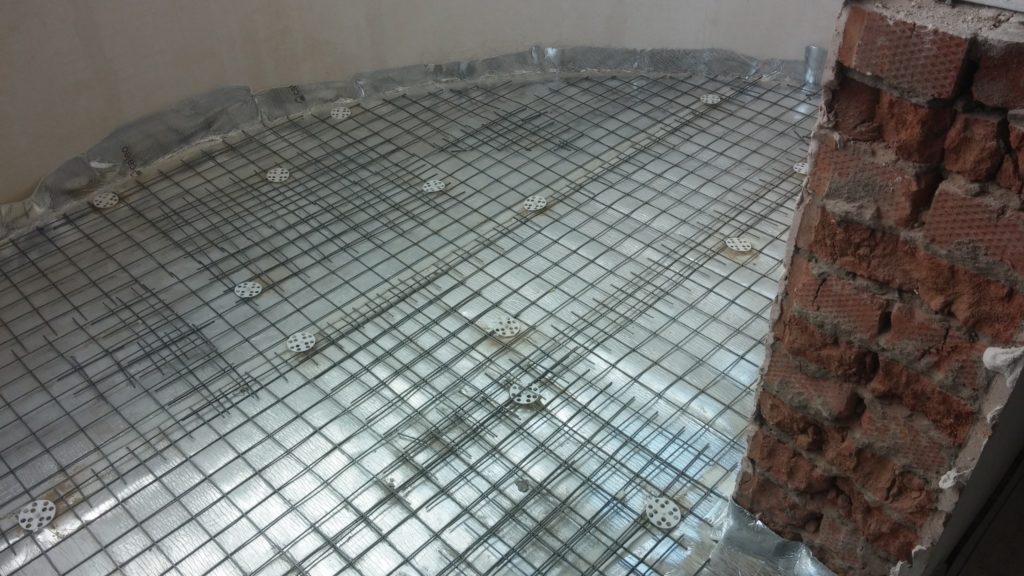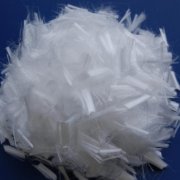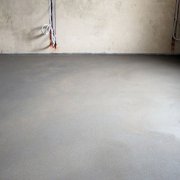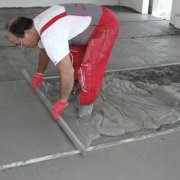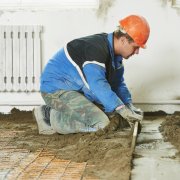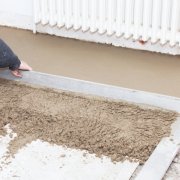Reinforcing floor screed: step by step instructions
The content of the article
The need for reinforcement
Reinforcement floor screed It is used to form a solid base for decorative flooring and protect concrete against damage during shrinkage.
Reinforcing mesh for screed reinforces concrete structures, prevents the formation of cracks, extends the life of the floor. The need for reinforcement arises in situations when:
- Floors are equipped on moving soils. The constant impact of groundwater, subsidence of the soil, and the unsteadiness of the soil lead to fractures, deformations and stretching of the concrete mass. Thanks to the reinforcement, a strong plate is formed that is resistant to these processes.
- A thin layer of concrete foundation is poured. In suburban single-story buildings, cottages erected on swampy soils or piles, it is forbidden to make excessively heavy thick screeds.
- It is planned to lay a floor heating circuit. The mesh under the screed is the basis for fixing the elements of underfloor heating.
- The floor is equipped in a technical room with heavy machines or conveyors. Reinforced screed withstands vertical mechanical stress to a greater extent than unreinforced.
- Planned installation of a fireplace.
- A multilayer floor with a thickness of more than 5 cm is arranged.
The main advantages of reinforcement and differences from conventional screed
Each homeowner decides independently whether reinforcement screeds are needed. Except for the situations described above, a masonry net for screed is used as desired. The benefits of reinforcement include the following factors:
- simplified alignment of the curved floor surface;
- lengthening the operational life of the equipped screed;
- resistance to cracking and kinks of concrete;
- conditions for the manufacture of a thin floor;
- saving costs for mortars;
- increased strength of the base of the floor, withstanding heavy equipment;
- lack of need to often repair and restore floors.
The appearance of a reinforced screed is no different from a non-reinforced screed.
Reinforcement Materials
Depending on the calculated thickness and the chosen floor structure, reinforcement materials are selected: metal, fiberglass or plastic net. The mesh size for the floor screed is set after calculating the work load, temperature expansion and other parameters.
- Metal fittings. It is made by welding together individual rods.
- Fiberglass (composite) fittings. It is made by connecting individual elements with special clamping devices made of plastic, wire or bundle binding.
- Plastic fittings. It is sold in the form of finished nets, it is cheaper than metal products, but it performs the same functions.
Metal grid
Screed net made of metal is susceptible to destructive moisture. The fittings are covered with corrosion and rust, it loses its properties. Therefore, for the manufacture of compression fittings, protective coatings of the rods are used. Galvanized is applied to the surface, protected by polymer and plastic shells.The choice of mesh is based on financial capabilities and technical conditions. When buying, pay attention to the state of the grid, examine the product for:
- quality of the weld joint. Many unscrupulous manufacturers do not boil every cell and skip two or three cells. This reduces the strength of the screed;
- signs of corrosion and browning. If there are signs of corrosion on the mesh, or the integrity of the protective layer is impaired, the fittings will quickly collapse during operation.
Material for the manufacture of metal mesh - rods or wire with a thickness of 0.25 cm or more. Typical cell sizes are 10x10 cm, 15x15 cm, 20x20 cm. The size of the wire thickness should be selected according to the load parameters for concrete, and the cell size should be chosen according to the thickness of the screed and the size of the fractions of the filling ingredient in the concrete. Small grooves-notches with an interval of 0, 3 cm are applied to the surface of the reinforcing wire to improve the adhesion characteristics of the mesh reinforcement with concrete.
Plastic nets
Reinforcing materials made of plastic are not afraid of corrosion damage, exposure to liquids and chemicals. Products remain strong and resistant to wear. Plastic mesh under the screed has the advantages of:
- light weight;
- minimal electrical conductivity;
- ease of installation;
- ease of use at the facility with non-standard architectural features;
- low price;
- ductility.
OSS nets are intended for general construction operations and are widely used in residential premises. Commodity form - rolls 10, 15 or 20 meters long with a width of 1-4 meters. Due to its low cost, this variety is popular with consumers.
Fiberglass mesh
The fiberglass mesh is a material with cells of 0.4-0.6 cm, woven openwork pattern. The fittings are sold in the form of a solid web or long rods (maximum length - 6 m). To increase the life of the mesh impregnated with special solutions that give the material resistance to alkaline effects. This is due to the fact that unprocessed fiberglass is destroyed after seven years of service. Improving adhesion to concrete provides a coating of fiberglass reinforcement products with quartz sand or ribbed profile structures.
The reasons for acquiring fiberglass mesh are as follows:
- the net is light in weight, does not load the clamp structure, is easily transported and transported;
- fiberglass structure prevents shrinkage damage, increases the strength of the screed;
- reinforcement of the screed with a fiberglass mesh makes the floors resistant to humidity and temperature differences.
For cement screeds in housing with medium and light load, the categories SSDor (reinforced mesh) or SSP-95 are used. When heated to a temperature of more than 200 degrees, the grid structure is destroyed. Consider the temperature when making the right choice of material, for example, when arranging heating or increased fire safety requirements in the building.
In the composite mesh category, in addition to fiberglass, carbon or basalt fiber and polymer impregnated products are used.
Fiber reinforcement
Fiber is a material of artificial origin, raw materials are polypropylene. The appearance of the fiber is fibrous white pieces, similar to translucent feathers, with a maximum length of 1.8 cm. The diameter of the fiber thread is twenty microns. Fiber characteristics - low conductivity and high adhesion to concrete due to treatment with an oily substance.
Fiber fiber is used when pouring screeds due to improved characteristics of cement:
- the screed can withstand frequent alternations of freezing and thawing;
- concrete is less susceptible to abrasion;
- screed operational period is lengthened;
- hardening time of the solution is reduced;
- concrete strength increases;
- the ability to absorb moisture is reduced;
- the screed is reliably protected from delamination, chips, fractures and cracks;
- increased resistance to mechanical stress;
- rough coating is resistant to sudden temperature changes.
In order to choose the right reinforcing material for the screed, it is advisable to consult with an experienced builder and take into account the technical tasks: the height of the room, the type of coating, the level of load on the floor, equipping with warm floors, the curvature of the base. The choice also determines the purpose of the grid:
- anchor (for using embedded elements);
- assembly (combines the grid with the fittings laid during the last repair);
- distribution (to hold possible expansion of concrete and shrinkage);
- working (to receive the load).
How to reinforce the floor screed?
To make the floor screed solid and durable, get a flat surface, follow the technological rules of reinforcement:
- Select the mesh size so that the concrete fractions freely penetrate the openings.
- Immerse the reinforcement in the concrete mass during the pouring process, and do not lay on the surface of the base. Make sure that no particles of filler protrude outward.
- Prepare the foundation correctly before pouring concrete. Clean the cement dust, close the cracks, lay vibration damping pads. This will reduce the load during the settlement of the structure.
- Lay the decorative coating no earlier than a month after pouring the screed, after the concrete has completely and completely solidified.
Subject to these rules, qualitative results are achieved: the screed is durable, does not collapse under the influence of mechanical and climatic effects.
Work order:
- Substrate preparation (cleaning, primer, dust removal, laying of waterproofing and damper tape 10 cm from the floor).
- Parallel laying of cloths of a grid with overlapping of edges by 10 centimeters. The distance from the wall is 3 centimeters.
- The rise of the grid above the surface. Installation of supports (pieces of plastic pipe, pieces of brick or special bars) at the points of intersection of the rods. The network is immersed in the thickness of concrete with minimal deflections. The distance between the supports is chosen according to the thickness of the concrete screed: the thicker the concrete layer, the denser the stands are installed to each other. The height of the grid above the surface is one or two centimeters.
Thin nets, which are sold in rolls, are laid on the bases and fixed at the edges.
- Checking the evenness of horizontal laying, adjusting the points of deviations of the plane with additional supports.
- Solution preparation and pouring. The reinforcement hides in the concrete mix and does not protrude outward after leveling.
Plastic and composite nets are spread on the primary fill (forty percent of the solution) after leveling with the rule, they are recessed and filled with the remainder of the solution. Repeat the alignment procedure.
Fiber screed reinforcement
Basalt, glass, metal fibers, polypropylene fibers are added to the solution dry. The material is introduced gradually and slowly, in portions, so that the reinforcing ingredient evenly spreads in the concrete mass. If you pour fiber into a container with a liquid solution at a time, then the strength of the screed will be heterogeneous. When the floor freezes, a solid monolithic plate is formed, which has a protective function against the formation of cracks on the surface.
Fiber reinforcement of the screed is carried out according to the standard lighthouse technology, which provides for pouring on level slats and subsequent alignment. An example of a technology for arranging semi-dry screeds with fiber fibers:
- Prepare the working surface in the fill: remove the litter, cut off the protrusions and flows, close the cracks, ground the surface and dry.
- After drying, mark the fill level on the walls and set up the beacons.
- Apply a layer of waterproofing.
- Prepare a semi-dry solution. Mix one part of Portland cement and three parts of sand in the tank, add half the volume of fiber (900 g of ingredient per 1 cubic meter of screed)
- Moisten the dry mixture with water, mix and gradually add, without interrupting mixing, the remainder of the fiber (a screed with a thickness of 5 cm takes 45 g of fiber per 1 square meter).
- Place the mortar in the beacons, level and compact with a roller or spatula.
- After a day, remove the lighthouses and seal up the traces of the slats with cement.
- Wait for the solution to set completely for 4 days. Periodically moisten and cover the screed with polyethylene.
- Proceed with the installation of the topcoat.
Video - Reinforced screed
We recommend that you familiarize yourself with the training video for a visual representation of screed reinforcement.
Some tips and tricks
- If you want to get a heavy-duty screed, apply at the same time the method of reinforcing using fiber and using polypropylene mesh material.
- In areas with increased seismic hazard, it is advisable to use basalt fiber fibers for screed reinforcement, which are inherently resistant to climatic disasters. The material strengthens the screed, prevents delamination and deformation.
- Due to the widespread falsification of polypropylene fiber, buyers risk acquiring a fake of dubious origin and quality. Buy goods in stores with a reliable reputation and ask sellers for a fiber quality certificate.
- With an insufficient budget, try to make a reinforcing mesh of wire yourself. See manufacturing recommendations on the Internet. We offer you to watch a video on the manufacture of semi-dry screed with fiberglass.
Video - Semi-dry fiber-reinforced screed
We offer you to watch a video on the manufacture of semi-dry screed with fiberglass.
Screed reinforcement is a complex procedure, but feasible for independent execution. Properly selected material, compliance with technological rules and building recommendations is a guarantee of strength and durability of the reinforced screed.
